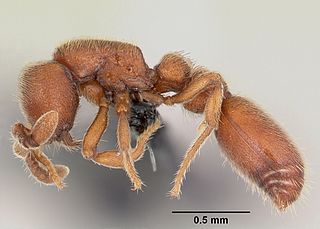
Hymenoptera is a large order of insects, comprising the sawflies, wasps, bees, and ants. Over 150,000 living species of Hymenoptera have been described, in addition to over 2,000 extinct ones. Many of the species are parasitic. Females typically have a special ovipositor for inserting eggs into hosts or places that are otherwise inaccessible. This ovipositor is often modified into a stinger. The young develop through holometabolism —that is, they have a wormlike larval stage and an inactive pupal stage before they reach adulthood.

Dorylinae is an ant subfamily, with distributions in both the Old World and New World. Brady et al. (2014) synonymized the previous dorylomorph subfamilies under Dorylinae, while Borowiec (2016) reviewed and revised the genera, resurrecting many genera which had previously been merged. Dorylinae genera are suggested to have evolved sometime between 102 to 74 million years ago, subsequently undergoing rapid adaptive radiation events during their early history.

Thelytoky is a type of parthenogenesis and is the absence of mating and subsequent production of all female diploid offspring as for example in aphids. Thelytokous parthenogenesis is rare among animals and reported in about 1,500 species, about 1 in 1,000 of described animal species, according to a 1984 study. It is more common in invertebrates, like arthropods, but it can occur in vertebrates, including salamanders, fish, and reptiles such as some whiptail lizards.
Cerapachys doryloides is a species of ant in the genus Cerapachys. It was discovered and described by Borowiec, M. L. in 2009.
Cerapachys eguchii is a species of ant in the genus Cerapachys. It was discovered and described by Borowiec, M. L. in 2009.

Ooceraea biroi, the clonal raider ant, is a queenless clonal ant in the genus Ooceraea. Native to the Asian mainland, this species has become invasive on tropical and subtropical islands throughout the world. Unlike most ants, which have reproductive queens and mostly nonreproductive workers, all individuals in a O. biroi colony reproduce clonally via thelytokous parthenogenesis. Like most dorylines, O. biroi are obligate myrmecophages and raid nests of other ant species to feed on the brood.

Anomalomyrma is an Asian genus of ants in the subfamily Leptanillinae. The genus was originally described in 1990 with the type species Anomalomyrma taylori, based on a single dealate queen from Borneo. Workers were unknown until 2011, when two new species were described from Peninsular Malaysia and the Philippines.

Protanilla is a genus of subterranean ants in the subfamily Leptanillinae. Known from the Indomalayan realm, the genus contains about thirteen species. The genus was erected by Taylor (1990) for the type species P. rafflesi, described from workers from Peninsular Malaysia. Species in this genus have long and downcurved mandibles with peg-like tooth on the inner margins. Four species are known from China, one from Taiwan, one from Sri Lanka and a couple from India.

Leptanilloides is a genus of ants in the subfamily Dorylinae. Leptanilloides is an uncommonly collected genus with subterranean habits in the New World Andean and sub-Andean tropics.

Cerapachys is a genus of ants in the subfamily Dorylinae. Species are mainly myrmecophagous ants which raid the nests of other ants for prey. The genus is distributed widely throughout the Indomalayan region. The genus was revised by BoroWiec (2016) who split a number of previously synonymized genera out of Cerapachys, leaving only 5 species in the genus.

Tyrannomyrmex is a rare tropical genus of ants in the subfamily Myrmicinae. Three similar species, only known from workers, are recognized and share small eyes and edentate mandibles.

Chrysapace is a genus of ants in the subfamily Dorylinae containing four described species. The genus is distributed across the Malaysian peninsula, Indonesia, and the Philippines, with undescribed species from Madagascar and from Baltic amber Chrysapace was described by Crawley (1924) and later placed as a junior synonym of Cerapachys by Brown (1975). Chrysapace was resurrected as a valid genus by Borowiec (2016) during redescription of the doryline genera.

Lioponera is a genus of ants in the subfamily Dorylinae containing approximately 74 described species. The genus is distributed widely across the Afrotropical, Australasia, Indomalaya, Malagasy, and Palearctic bioregions. Lioponera was described by Mayr (1879) and later placed as a junior synonym of Cerapachys by Brown (1975). Lioponera was resurrected as a valid genus by Borowiec (2016) during redescription of the doryline genera.

Ooceraea is a genus of ants in the subfamily Dorylinae containing approximately 16 described species. The genus is distributed across the Australasia, Indomalaya, Malagasy, Neotropical, Oceania, and Palearctic bioregions. Ooceraea was described by Roger (1862) and later placed as a junior synonym of Cerapachys by Brown (1973). Ooceraea was resurrected as a valid genus by Borowiec (2016) during redescription of the doryline genera.

Parasyscia is a genus of ants in the subfamily Dorylinae containing approximately 50 described species. The genus is distributed across the Afrotropical, Australasia, Indomalaya, Malagasy, Oceania, and Palearctic bioregions. Parasyscia was described by Carlo Emery (1882), moved to a subgenus of Cerapachys by Forel (1892) and finally placed as a junior synonym of Cerapachys by Kempf (1972). Parasyscia was resurrected as a valid genus by Borowiec (2016) during the redescription of the doryline genera.

Syscia is a genus of ants in the subfamily Dorylinae containing thirty eight described species. The genus is distributed widely across the Eastern Asia, North America, and South America. Syscia was described by Roger (1861), later placed as a Cerapachys subgenus by Wheeler (1902) and then junior synonym of Cerapachys by Kempf (1972). Syscia was resurrected as a valid genus by Borowiec (2016) during redescription of the doryline genera.

Yunodorylus is a genus of ants in the subfamily Dorylinae containing four described species. The genus is distributed widely across mainland Southeast Asia and the island of Borneo. Yunodorylus was described in 2000, later placed as a junior synonym of Cerapachys by Bolton (2003), and was resurrected as a valid genus by Borowiec (2016)













